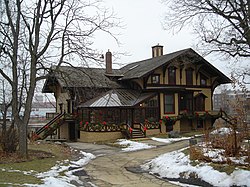
The Herbert Hoover National Historic Site is a unit of the National Park System in West Branch, Iowa, United States. The buildings and grounds are managed by the National Park Service to commemorate the life of Herbert Hoover, the 31st president of the United States. The park was established in 1965, shortly after it was named a National Historic Landmark. It now encompasses 186.8 acres (75.6 ha).

Rockford is a city in Winnebago County, Illinois, located in the far northern part of the state. Situated on the banks of the Rock River, Rockford is the county seat of Winnebago County. The largest city in Illinois outside of the Chicago metropolitan area, Rockford is the fourth-largest city in the state and the 171st most populous in the United States. According to 2020 U.S. Census data, the City of Rockford had a population of 148,655 with an outlying metropolitan area population of 348,360.

The Burpee Museum of Natural History is located along the Rock River in downtown Rockford, Illinois, United States, at 737 North Main Street.
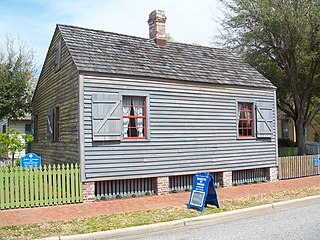
The Pensacola Historic District is a U.S. historic district located in Pensacola, Florida.

The David Davis Mansion, also known as Clover Lawn, is a Victorian home in Bloomington, Illinois that was the residence of David Davis, Supreme Court justice (1862–1877) and Senator from Illinois. The mansion has been a state museum since 1960. It was added to the National Register of Historic Places in 1972 and was designated a National Historic Landmark in 1975. In celebration of the 2018 Illinois Bicentennial, David Davis Mansion was selected as one of the Illinois 200 Great Places by the American Institute of Architects Illinois component.

Grumblethorpe, in Germantown, Philadelphia, Pennsylvania, was the home of the Wister family, who lived there for over 160 years. It was built in 1744 as a summer residence, but it became the family's year-round residence in 1793. It is a museum, part of the Colonial Germantown Historic District.

The Magnolia Mound Plantation House is a French Creole house constructed in 1791 near the Mississippi River in Baton Rouge, Louisiana. Many period documents refer to the plantation as Mount Magnolia. The house and several original outbuildings on the grounds of Magnolia Mound Plantation are examples of the vernacular architectural influences of early settlers from France and the West Indies. The complex is owned by the city of Baton Rouge and maintained by its Recreation Commission (BREC). It is located approximately one mile south of downtown.

Montgomery Place, now Bard College: The Montgomery Place Campus, near Barrytown, New York, United States, is an early 19th-century estate that has been designated a National Historic Landmark. It is also a contributing property to the Hudson River Historic District, itself a National Historic Landmark. It is a Federal-style house, with expansion designed by architect Alexander Jackson Davis. It reflects the tastes of a younger, post-Revolutionary generation of wealthy landowners in the Livingston family who were beginning to be influenced by French trends in home design, moving beyond the strictly English models exemplified by Clermont Manor a short distance up the Hudson River. It is the only Hudson Valley estate house from this era that survives intact, and Davis's only surviving neoclassical country house.

Locust Grove is a National Historic Landmark estate located on US 9 in the Town of Poughkeepsie, New York. The 200-acre park-like estate includes homes, a carriage house, ice house, trails, a flower garden, and vegetable garden, and it overlooks the Hudson River from a bluff. The property includes a home designed by architect Alexander Jackson Davis for Samuel F. B. Morse, the inventor of the telegraph. An Italianate style mansion, it was completed in 1851.
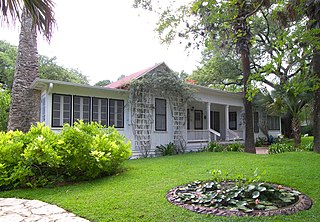
The Mayfield–Gutsch Estate, now named Mayfield Park, is a historic cottage, gardens and nature preserve in west Austin, Texas on a bluff overlooking Lake Austin. Originally built in the 1870s, the cottage was purchased by former Texas Secretary of State Allison Mayfield in 1909. In 1922, the house passed to Mayfield's daughter, Mary Frances, and her husband, University of Texas professor Milton Gutsch. They expanded the home, adding porches on three sides and, with the help of gardener Esteban Arredondo, greatly developed 2 acres (0.81 ha) of the property around their home into a botanical garden surrounded by a rock perimeter wall. When Mary Mayfield Gutsch died in 1971, the home and grounds were left to the City of Austin for use as a park. The property was listed on the National Register of Historic Places on September 29, 1994.

The Edsel and Eleanor Ford House is a mansion located at 1100 Lake Shore Drive in Grosse Pointe Shores, northeast of Detroit, Michigan; it stands on the site known as "Gaukler Point", on the shore of Lake St. Clair. The house became the new residence of the Edsel and Eleanor Ford family in 1928. Edsel Ford was the son of Henry Ford and an executive at Ford Motor Company. The estate's buildings were designed by architect Albert Kahn, its site plan and gardens by renowned landscape designer Jens Jensen. The property was listed on the National Register of Historic Places in 1979, and was designated a National Historic Landmark in 2016.

The Laura Ingalls Wilder House is a historic house museum at 3060 Highway A in Mansfield, Missouri. Also known as Rocky Ridge Farm, it was the home of author Laura Ingalls Wilder from 1896 until her death in 1957. The author of the Little House on the Prairie series, Wilder began writing the series while living there. The house, together with the nearby Rock Cottage on the same property, represents one of the few surviving places where she resided. Shortly after her death local residents initiated legal steps to acquire the house through the incorporation of a non-profit organization to preserve her legacy. Owned by the Laura Ingalls Wilder Home Association, the house is open to the public for tours. It was designated a National Historic Landmark in 1991.

The Pfau–Crichton Cottage, best known as Chinaberry, is a historic cottage in Mobile, Alabama. The 1+1⁄2-story, wood-frame, Gulf Coast cottage was completed in 1862. The house was built by the Pfau family, but its best known resident was Miss Anne Randolph Crichton, known for the elaborate gardens that she developed on the property. She enlisted in the Navy at the outbreak of World War I and continued her service until retirement, in the 1950s. She traveled extensively in Europe during the 1930s, maintaining scrapbooks that recorded her visits to various art museums, gardens, and monuments. She was the last direct descendant of Hugh Randolph Crichton, the founder of the Mobile County town of Crichton. The house was added to the National Register of Historic Places on October 18, 1984, as a part of the 19th Century Spring Hill Neighborhood Thematic Resource listing of well-preserved buildings that represent the historical development of what was once the village of Spring Hill.

John Henry Manny (1825–1856) was the inventor of the Manny Reaper, one of various makes of reaper used to harvest grain in the 19th century. Cyrus McCormick III, in his Century of the Reaper, called Manny "the most brilliant and successful of all Cyrus McCormick's competitors," a field of many brilliant people.

McPike Mansion, or Mount Lookout, is a mansion in Alton, which is part of the Metro-East region of the Greater St. Louis metropolitan area in the U.S. state of Illinois. Built in 1869 by Henry Guest McPike (1825–1910), it is situated on Alby Street on a site of 15 acres (61,000 m2), one of the highest points in Alton, which was called Mount Lookout.
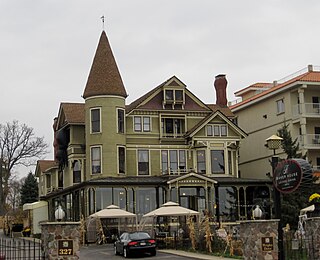
Redwood Cottage is a Queen Anne-styled mansion built in 1885 as a summer cottage in Lake Geneva, Wisconsin. Later it served as a sanitarium and later as a hotel. In 1984 the house was listed on the National Register of Historic Places.

The Sidney Lanier Cottage is a historic cottage on High Street in Macon, Georgia, that was the birthplace of poet, musician, and soldier Sidney Lanier. Sidney Lanier Cottage was purchased by the Middle Georgia Historical Society in 1973, and opened to the public in 1975. The Sidney Lanier Cottage now serves as a museum, event space, and home of the Lanier Center for Literary Arts.

The Amos Catlin Spafford is a historic residence in Rockford, Illinois, United States.
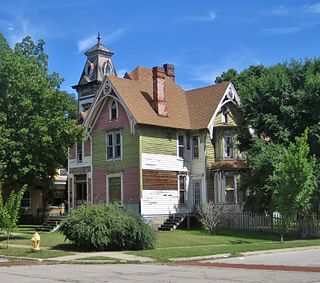
The Haight Village Historic District is an area in Rockford, Illinois reflecting the city's early residential development.

Meroogal is a heritage-listed former residence and now house museum at 35 West Street, Nowra, City of Shoalhaven, New South Wales, Australia. It was designed by Kenneth Mackenzie and built in 1886 by Kenneth Mackenzie. The property is owned by the Historic Houses Trust of New South Wales. It was added to the New South Wales State Heritage Register on 2 April 1999.
